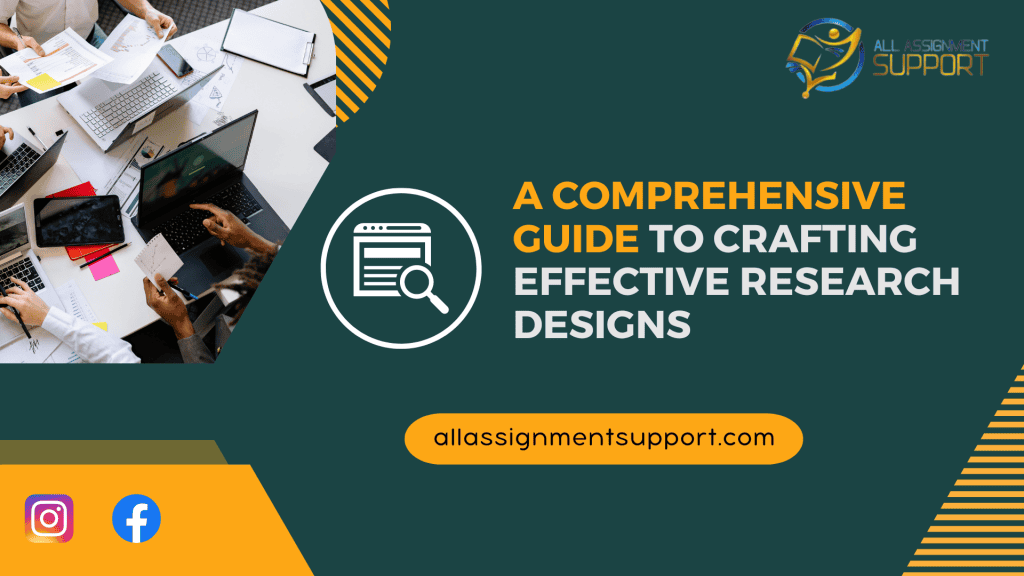Table of Contents
ToggleIntroduction
Before embarking on any research endeavor, having a well-structured and thought-out research design is crucial. A research design serves as the blueprint for your study, outlining the methods, procedures, and strategies you’ll employ to answer your research questions or test hypotheses.
In this comprehensive guide, we’ll break down the critical components of a research design, providing step-by-step instructions to help you create a robust and effective plan for your research project.
Understanding the Basics of Research Design
A well-defined and meticulously crafted research design is at the heart of any successful research endeavor. A research design serves as the strategic blueprint that outlines the systematic plan for conducting your study. The roadmap guides you through the intricate data collection, analysis, and interpretation landscape. Simply put, a research design is an architectural framework for the entire research process.
A research design encompasses your decisions regarding the methods, procedures, tools, and techniques you will employ to investigate your research questions or test your hypotheses. It’s not just a formality; it’s the very essence that shapes your study’s structure and determines the validity and reliability of your findings.
The careful construction of a research design enhances your ability to draw accurate conclusions and contributes to the credibility of your research within the academic community.
The nuances of how to write a research design have been caricatured precisely and accurately through the steps given here!
Types of Research Designs
As you delve into the world of research design, you’ll encounter an array of design types, each tailored to suit specific research objectives and questions. Let’s explore some of the most prominent types of research designs:
1. Experimental Design
This design is synonymous with controlled experimentation. It involves manipulating variables to observe their effects and establish causal relationships. Experimental designs are particularly useful for testing cause-and-effect hypotheses, as they allow researchers to exert control over extraneous variables. Using evaluative designs, you can create compelling templates on how to design a research project after all.
2. Observational Design
In this approach, researchers observe and record phenomena in their natural settings without intervention or manipulation. This design type is valuable when studying behaviors, patterns, and occurrences within their real-world contexts. It provides insights into how things naturally unfold. Designers also work on the research design outline to get things done to perfection.
3. Qualitative Design
Qualitative research delves into the depth and complexity of human experiences, perceptions, and behaviors. This design involves methods such as interviews, focus groups, and content analysis, aiming to uncover rich insights and themes that quantitative approaches might overlook.
4. Quantitative Design
Quantitative research, on the other hand, emphasizes numerical data and statistical analysis. It involves collecting and analyzing structured data to identify patterns, correlations, and trends, enabling researchers to make generalizations about populations.
Read Also: Essay Writing Topics for College Students
Clarifying Your Research Objectives
As you embark on your journey, the compass guiding your efforts is formulating clear, focused research questions or hypotheses. These fundamental elements serve as the guiding lights, steering your study toward meaningful discoveries and insights.
To draw up the tabulation for building a research design is also something you aim to work on.
Let us look into how your research objectives are fulfilled insightfully. Helping you get started concerning the same:
1. Research Questions
Research questions are the curious queries that prompt your investigation. They should encapsulate the essence of what you seek to understand or explore. When formulating research questions, consider the SMART criteria: Specific, Measurable, Achievable, Relevant, and Time-bound. By adhering to these principles, your questions become inquisitive musings and concrete objectives that fuel your research.
For instance, instead of asking a vague question like “What are the effects of climate change?” consider crafting a SMART research question such as “How does a 2-degree Celsius increase in global temperature impact the frequency and intensity of extreme weather events over the next decade?”. Defining plans on how to write a research design can also be done in the form of templates or flow charts.
2. Hypotheses
Hypotheses are statements that propose an expected relationship between variables. They are the foundation for experimental research, guiding your investigation toward empirical testing. Similar to research questions, hypotheses should conform to the SMART criteria, ensuring they are precise and testable.
In the context of the example above, a hypothesis could be “If global temperatures rise by 2 degrees Celsius, then the occurrence of severe hurricanes and heatwaves will increase by 20% over the next ten years”.
Defining Variables
Variables are the building blocks of your study—those elements that can change, vary, or be measured. They are divided into independent and dependent variables, and understanding their relationship is pivotal to unraveling the nuances of your research. With respect to how to design a research project, these are know-how stuff you got to capture.
1. Independent Variable
The independent variable is the one you manipulate or control in an experimental study. The reason you think something has an impact on another is the cause. In the case of climate change effects, the independent variable would be the global temperature increase.
2. Dependent Variable
The dependent variable is the one that you measure or observe to determine the outcome of your study. The factor you anticipate the independent variable to have an impact on is the effect. In our climate change example, the dependent variables could be the occurrences of severe hurricanes and heatwaves.
3. Relationships Between Variables
Explaining the anticipated relationships between your variables is essential. In our example, you would hypothesize that as the global temperature rises (independent variable), the frequency and intensity of extreme weather events (dependent variables) will also increase. This connection between the variables is the crux of your study, where your investigation seeks to validate or refute your hypothesis.
Designing Your Research Methodology
A robust research design is akin to a finely tuned orchestra—each instrument (methodology) plays a distinct role, harmonizing to produce a symphony of insightful findings. This section unveils the intricate steps involved in sculpting an effective research methodology, where your decisions shape the very fabric of your study.
At the crossroads of your research journey, you encounter a pivotal choice: the research approach. Will your study adopt a deductive (quantitative) or inductive (qualitative) path? Each course carries distinct characteristics that profoundly influence how you collect, analyze, and interpret data.
Google templates on the different types of research design so that you get started without a glitch! Let us look at the kinds of approaches we take to analyze research data in a more tabulated and streamlined manner. Helping you get started with the same:
1. Deductive Approach (Quantitative)
In the deductive approach, you start with a well-defined hypothesis or theory and seek to test it through systematic data collection and statistical analysis. This approach is often associated with numbers, measurements, and statistical tests that provide objective insights. It’s like constructing a puzzle by fitting pieces together based on predefined patterns.
2. Inductive Approach (Qualitative)
The inductive approach, on the other hand, emphasizes exploration and discovery. Here, you gather data without preconceived notions and aim to uncover patterns, themes, and relationships. This approach involves immersion in the data, often through methods like interviews, observations, and content analysis. It’s akin to assembling a puzzle without a predetermined picture, allowing the emerging patterns to shape the outcome.
Read Also: Statistics Project Ideas
Selecting Participants or Samples
With your chosen approach in mind, the next step is to identify the participants or samples that will form the basis of your study. Defining your target population—the group of individuals or entities you wish to study—is essential. However, studying an entire population is often impractical, leading to the need for sampling.
1. Sampling Methods
Different sampling methods offer various advantages and limitations, such as random, stratified, convenience, or purposive sampling. The choice depends on factors like your sample’s representativeness, participants’ availability, and the resources at your disposal.
Justify your choice of sampling method by considering the feasibility of accessing participants, the relevance of the sample to your research objectives, and the potential impact of sampling biases on your findings.
2. Data Collection Techniques
With participants or samples identified, you venture into the realm of data collection techniques—those tools you’ll employ to gather information that will answer your research questions or test your hypotheses.
3. Methods
Data collection can encompass surveys, interviews, observations, experiments, or a blend of these methods. Each method offers unique insights and challenges. Surveys provide structured quantitative data, interviews delve into rich qualitative narratives, observations capture behaviors in natural settings, and experiments allow cause-and-effect exploration.
4. Rationale and Data Quality
Clearly articulate the reasons behind your choice of data collection methods. Explain how each approach aligns with your research objectives and how you’ll ensure the quality, reliability, and validity of the data collected. Discuss strategies for minimizing biases, ensuring participant anonymity, and maintaining consistency in data collection.
Ensuring Ethical Considerations
As researchers, we bear a profound responsibility—to unravel the mysteries of our world while safeguarding the rights, well-being, and dignity of those who contribute to our quest for knowledge. Ethical considerations stand as the moral compass that guides our actions and decisions throughout the research journey.
1. Informed Consent
One of the cornerstones of ethical research is informed consent. It entails transparently communicating the study’s purpose, procedures, potential risks, and benefits to participants. Individuals should voluntarily agree to participate with a comprehensive understanding of their involvement. This ensures that their autonomy and right to make an informed choice are respected.
2. Participant Confidentiality
Confidentiality is paramount. Ensure that any information shared by participants remains confidential and is used solely for research purposes. Assure participants that their identity will be protected and that data will be reported in aggregate form whenever possible.
3. Potential Risks
Carefully assess the potential risks associated with your study, whether physical, emotional, social, or psychological. Minimize these risks and, where necessary, provide appropriate support mechanisms for participants. Your research’s benefits should outweigh the potential harms.
4. Ethical Approval Process
Depending on the nature of your study and the institutions involved, you may need to seek ethical approval. Institutional Review Boards (IRBs) or Ethics Committees evaluate research proposals to ensure they meet ethical standards. Describe how you plan to submit your study for ethical review, outlining the steps you’ll take to ensure compliance with established guidelines.
5. Participant Welfare
Prioritize the well-being of your participants. If your research involves vulnerable populations (such as children, the elderly, or marginalized groups), take extra precautions to protect their rights and ensure their safety throughout the study.
6. Balancing Research and Ethics
Strike a delicate balance between your research objectives and ethical considerations. While your pursuit of knowledge is important, it should never come at the expense of participants’ rights or well-being.
7. Transparency
Clearly detail your ethical considerations in your research proposal or report. This demonstrates your commitment to conducting ethical research and upholds the credibility of your study.
By weaving ethical considerations into the fabric of your research design, you not only adhere to ethical guidelines but also demonstrate integrity and respect for the individuals who contribute to the advancement of knowledge.
Planning Data Analysis
The culmination of your research journey is the analysis of the data you’ve painstakingly collected. This phase is where the raw information transforms into meaningful insights, and the threads of your study are woven into a coherent narrative. Here, we explore strategies for effective data analysis, whether your study is quantitative or qualitative in nature.
1. Quantitative Studies
If your research design is quantitative, your data analysis hinges on statistical methods. Detail the specific statistical tests you plan to use to analyze your data. These tests depend on the type of data you’ve collected and the nature of your research questions. Be transparent about your approach, explaining how each test aligns with your research objectives and how you’ll interpret the results.
For example, if you’re investigating the relationship between two variables, you might mention using correlation or regression analysis to quantify the association between them.
2. Qualitative Studies
In qualitative studies, your data analysis involves delving into your data’s rich narratives and themes. Describe the coding process—systematically categorizing data into themes or concepts. Outline how you’ll engage in thematic analysis, identifying recurring patterns, insights, and perspectives from your data.
Explain how you’ll maintain rigor in your analysis by employing techniques like member checking (validating findings with participants) or peer debriefing (having colleagues review your interpretations).
3. Triangulation
To elevate the credibility of your findings, consider the powerful triangulation technique. This involves integrating multiple methods or data sources to converge on a more comprehensive understanding of the research phenomenon. By triangulating, you cross-validate your results, enhancing the trustworthiness of your findings.
For instance, if you’re exploring a social issue through qualitative interviews, you might triangulate by analyzing related documents, conducting surveys with a broader sample, or observing the phenomenon in its natural context. Triangulation bolsters the reliability of your results and offers a holistic perspective on the research subject.
Addressing Potential Limitations
In the pursuit of knowledge, acknowledging the limitations of your research design is not a sign of weakness but a demonstration of scholarly rigor. Just as a skilled captain navigates the waters while keeping an eye on potential obstacles, a researcher must identify and address potential limitations to ensure the integrity of their findings. Here, we explore how to anticipate and mitigate limitations that could impact the outcomes of your study.
Begin by critically evaluating your research design, methods, and data collection process. Anticipate where vulnerabilities might arise, such as:
1. Sampling Bias
The selected sample might not accurately represent the broader population due to its size, composition, or method of selection.
2. Measurement Errors
Data collection instruments might not perfectly measure the variables of interest, leading to inaccuracies.
3. Confounding Variables
Uncontrolled factors might influence the relationship between the variables you’re studying.
4. Generalization of data variables
Findings might be applicable only to a specific context or time, limiting their broader relevance.
5. Ethical Limitations
Ethical considerations could restrict the scope or implementation of your study.
Mitigating Limitations
Mitigating limitations demonstrates your commitment to conducting thorough and credible research. Consider the following strategies:
1. Sampling Strategies
Opt for a sampling strategy that enhances the representativeness of your sample, such as stratified sampling or random sampling.
2. Validity and Reliability
Establish the validity and reliability of your measurement instruments through piloting, pre-testing, and using established measures when possible.
3. Control Variables
Identify potential confounding variables and either control for them in your analysis or acknowledge their potential influence on your results.
4. Contextualization
Clearly outline the scope and context of your findings, explaining their applicability and any potential limitations in generalizability.
5. Ethical Considerations
Detail the ethical considerations you’ve taken to ensure the well-being of participants and the integrity of your study.
Impact on Study Outcomes
It’s essential to be transparent about the potential impact of limitations on your study’s outcomes. Explain how these limitations might affect the validity, reliability, or generalizability of your findings. By openly addressing these concerns, you’re demonstrating intellectual honesty and providing readers with a complete understanding of the strengths and weaknesses of your study.
Read Also: Argumentative Essay Topics
Creating a Timeline and Budget
Crafting a comprehensive project timeline is akin to plotting the course of your research journey, setting sail toward your destination with clarity and purpose. A well-structured timeline ensures that you navigate the intricate phases of your study efficiently and effectively.
1. Proposal Writing
This marks the inception of your journey. Dedicate ample time to refining your research objectives, design, and methodology. Aim to complete your proposal within a set period, allowing for revisions and feedback.
2. Ethical Approval
Allocate time for the ethical review process. Ethical considerations are crucial, and obtaining approval may require revisions to your design or additional documentation.
3. Participant Recruitment
If your study involves participants, outline the period for recruitment. Factor in time for reaching out, obtaining informed consent, and ensuring a diverse and representative sample.
4. Data Collection
Whether through surveys, interviews, observations, or experiments, establish a timeframe for data collection. Consider potential delays due to unforeseen circumstances and plan accordingly.
5. Data Analysis
This phase requires meticulous attention. Allocate sufficient time for processing, analyzing, and interpreting your data, especially if your analysis involves complex statistical tests or qualitative coding.
6. Report Writing
The culmination of your efforts, report writing, deserves dedicated time. Outline the structure of your report, allocate time for crafting clear and concise prose, and ensure you address each section comprehensively.
7. Review and Revision
Set aside time for review and revision. This phase allows you to fine-tune your report, ensure logical flow, and eliminate errors or inconsistencies.
8. Final Submission
Mark the deadline for submitting your completed research. Give yourself a buffer to handle any unforeseen delays that might arise.
By mapping out these milestones and assigning realistic timeframes, you’re fostering a disciplined approach that prevents last-minute rushes and ensures each phase receives the attention it deserves.
Budget Considerations
Conducting research often involves financial considerations. Estimating and managing your budget is essential to ensuring the smooth execution of your study.
1. Materials and Equipment
List the materials, tools, or equipment necessary for data collection, analysis, or experiments. Research costs might include specialized software, laboratory supplies, or research instruments.
2. Participant Compensation
If your study involves participants who need compensation for their time or effort, budget accordingly.
3. Travel Expenses
If your research requires travel, account for transportation, accommodation, and any related costs.
4. Data Analysis Software
If specialized software is required for data analysis, allocate funds for its purchase or licensing.
5. Publication Fees
Consider potential costs associated with publishing your research findings, such as journal submission fees or open-access publication charges.
6. Contingency
Allow for a contingency fund to address unexpected expenses that may arise during the course of your research.
Creating a budget provides clarity and control over your research expenditures, helping you make informed decisions and manage resources effectively.
Communicating Your Research Design
A well-crafted research proposal serves as the bridge between the intricate architecture of your research design and the broader audience that will engage with your work. Whether you’re presenting to stakeholders, seeking guidance from advisors, or seeking funding from potential sponsors, your research proposal should effectively convey the essence, significance, and structure of your study.
1. Introduction and Background
Begin with a compelling introduction that outlines the context and significance of your research. Clearly articulate the research problem you intend to address and its relevance to your field. Provide a concise overview of the existing literature to establish the foundation of your study.
2. Research Objectives
State your research objectives, whether they’re research questions, hypotheses, or exploration aims. Make sure they are specific, measurable, achievable, relevant, and time-bound (SMART), setting the stage for the rest of your proposal.
3. Research Design and Methodology
Describe your chosen research design and methodology in detail. Clearly explain whether your study is quantitative, qualitative, or mixed-methods, and elaborate on how you plan to collect and analyze data. Justify your choices based on their alignment with your research objectives and expected outcomes.
4. Sampling and Data Collection
Outline your approach to sampling, including the target population, sampling method, and anticipated sample size. Detail the data collection techniques you’ll use, whether they involve surveys, interviews, observations, or experiments.
5. Ethical Considerations
Discuss the ethical considerations of your study, including informed consent, participant confidentiality, and any measures you’ve taken to mitigate potential risks. Highlight your commitment to ethical research practices.
6. Data Analysis
Describe the methods you’ll employ to analyze your data. For quantitative studies, mention the statistical tests you’ll use; for qualitative studies, outline your coding and thematic analysis procedures.
7. Project Timeline and Budget
Provide a timeline outlining the key milestones and deadlines for each phase of your research. If applicable, present a budget that estimates the costs associated with your study, including materials, participant compensation, software, and other expenses.
8. Expected Contribution
Articulate how your research contributes to the existing body of knowledge in your field. Highlight the potential impact of your findings and how they may address gaps or advance understanding.
9. Conclusion
Sum up your proposal with a concise conclusion that reaffirms the importance of your research and its alignment with your research design. Leave your audience with a clear sense of the journey you’re embarking upon.
10. References
Include a comprehensive list of the references you’ve cited throughout your proposal, demonstrating the foundation of your research in existing scholarship.
Crafting a research proposal requires a delicate balance between depth and clarity. You want to provide enough detail to convey your research design effectively, but also ensure that the proposal remains engaging and accessible to your audience. By following this structure and refining your language, you’ll create a research proposal that not only showcases your research design’s sophistication but also resonates with the stakeholders, advisors, and potential funders who will play a role in your research journey.
Conclusion
Here we have seen a step-by-step on how the research design outline has been derived at. A well-structured research design is the backbone of any successful research project. Following the steps outlined in this guide, you’ll be better equipped to create a research design that aligns with your objectives, adheres to ethical standards, and sets the stage for reliable and meaningful findings.
In case you are unable to create a research design on your own, you can always rely on Allassignmentsupport.com for help. Remember that research design is dynamic, and adjustments may be necessary as your project evolves. Stay open to refining your plan as you gather insights and continue researching.
Frequently Asked Questions (FAQ’s)
1. Can I combine qualitative and quantitative research designs in one study?
Yes, combining both qualitative and quantitative methods is known as a mixed-methods research design. This approach allows researchers to gain a comprehensive understanding of a research question by triangulating findings from different perspectives.
2. How do I determine the appropriate sample size for my study?
The sample size depends on factors such as the research design, the type of analysis, and the level of desired precision. Statistical formulas or software can help calculate a suitable sample size based on factors like desired confidence level and effect size.
3. What is the difference between reliability and validity in research design?
Reliability refers to the consistency and stability of measurement, ensuring that results can be reproduced. Validity, on the other hand, assesses whether a measurement accurately captures what it’s intended to measure.
4. How can I enhance the credibility of qualitative research findings?
To enhance credibility, qualitative researchers can engage in member checking (validating findings with participants), use multiple researchers to independently analyze data (peer debriefing), and provide a clear audit trail of decisions made during analysis.
5. How do I handle missing data in my quantitative study?
Missing data can be addressed through techniques such as imputation, where missing values are estimated based on existing data, or by conducting sensitivity analyses to assess the potential impact of missing data on results.
6. What is the difference between cross-sectional and longitudinal research designs?
Cross-sectional designs involve data collection at a single point in time to observe a snapshot of a population. Longitudinal designs involve repeated data collection over an extended period to study changes and developments within the same sample.
7. How can I increase the external validity of my study?
External validity refers to the generalizability of study findings to broader populations or settings. To enhance external validity, researchers can use random sampling, carefully define inclusion criteria, and consider replication studies.
8. What considerations should I keep in mind when conducting research involving human participants?
When involving human participants, researchers must obtain informed consent, ensure participant confidentiality, minimize potential risks, and uphold ethical standards throughout the study.
9. How do I ensure the reliability of data collection in observational research?
In observational research, reliability can be enhanced through training observers to ensure consistency in data collection, conducting inter-rater reliability tests, and using established protocols.
10. Can I modify my research design during the course of the study?
While it’s best to stick to the original research design to maintain the integrity of the study, some modifications might be necessary due to unforeseen circumstances. Any modifications should be well-justified and transparently documented.











